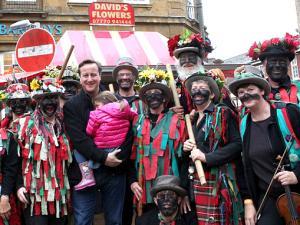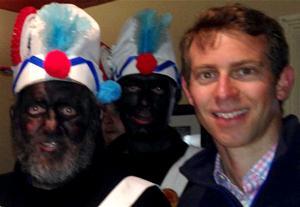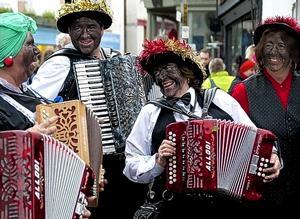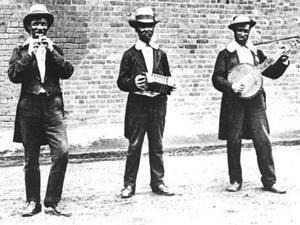 In British folk tradition blacking-up used to be known as ‘niggering’. Now, of course, it has nothing whatsoever to do with that… or so the defenders of David Cameron would have us believe after the Prime Minister was pictured surrounded by blackfaced morris dancers last weekend.
In British folk tradition blacking-up used to be known as ‘niggering’. Now, of course, it has nothing whatsoever to do with that… or so the defenders of David Cameron would have us believe after the Prime Minister was pictured surrounded by blackfaced morris dancers last weekend.
An innocent medieval custom adopted by the Brits to disguise themselves while begging for Christmas cash is one of the defences on offer. And there is historical evidence to support that. But this is a highly selective slice of the whole story. Looking through one eye, supporters of blackface folk traditions see no evil. But they daren’t open the other eye in case they see the connections with slavery, racism, minstrelsy and imported American Jim Crow-ism which, in many ways, contradicts the innocent version.
Reaction to Cameron posing with the morris dancers at a Banbury folk festival – during Black History Month – has been muted. Martin Kettle, writing in The Guardian, noted inaccurately that the tradition had nothing to do with insulting black people but remarked that much festivals showed how Britain was many nations “and all too few people pass with ease between them.” Dr Omar Khan, director of the race equality think-tank the Runnymede Trust also tackled the defenders of such practices, commenting:
“Britain’s leaders must reject the notion that because a practice dates back centuries it is clearly justifiable or does relatively little harm. Explaining the history of a tradition does not defend it, nor can practices – however ancient – that tap into racist stereotypes about the inferiority of black people ever be justified.”
Whatever justifications there may be start to disintegrate once the light of history is shone on it. Theresa Jill Buckland notes, in her 1990 book ‘Black Faces, Garlands, and Coconuts‘: “For most boys blackening the face was sufficient to identify themselves as niggers.” She also examined coconut dancing, which was known as ‘niggering.’

Will Straw and the Britannia Coconut Dancers
Earlier this year Labour candidate and son of a former home secretary Will Straw launched a defence of coconut dancing after he was pictured with the Britannia Coconut Dancers of Bacup in Lancaster, near his prospective constituency, saying critics should “mug up on their history” before adding: “it’s traditions from the past which give communities a sense of common identity for the present and the future. May the Coconutters continue for many years to come.”
Buckland points out that the coconutting tradition originated when Moors from north Africa settled in England, inspiring a stage melodrama in 1824 called ‘Agamemnon, the Faithful Negro’ and the bluebeard pantomime in Bradford which included ‘a number of juvenile black slaves, who perform the Cocoa Nut Dance.’
There is also evidence not only that the name ‘morris’ dancing harks from the term ‘Moorish’ but that Moorish dancing was absorbed into British folk customs. Bloody foreigners, coming over here, giving Brits their traditional culture.
Not all morris dancers blacken their faces, indeed nor do all ‘mummer’ festivals, but some of those that do take their ‘inspiration’ from African people, as Patricia Bater noted in her research for the National Centre for English Cultural Tradition.
One mummer festival that actually admits to an African connection is the annual winter solstice celebration in Padstow in Cornwall. Until recently they used to call it ‘Darkie Day’ and claim, dubiously, it began after Cornish locals witnessed slaves dancing for joy on the deck of a grounded slave ship.

Blackfaced revellers
There is no historical record of any slave ship running aground in the area, and even if it did – which it didn’t – it is highly unlikely the slavers would undo the chains of Africans in the hold to dance merrily on the deck.
The late and legendary MP Bernie Grant condemned the tradition as “offensive to black people all over the place” and Diane Abbott later put down a Commons Early Day Motion about Padstow.
But locals still don comic Afro-wigs and black face paint to this day each early January.
A number of minstrel songs were adopted by Padstow and right up to the 1980s local schools were still teaching children a tune called ‘Little Nigger.’
Padstow residents also used to sing a minstrel song called ‘Uncle Ned’ which went:
On a cold and frosty morning my Uncle Neddy died,
And he died many years ago.
He had no woolly on the toppy of his head
In the place where the woolly ought to go.
Up with the shovel and a ee-aye-oh
And down with the shovel and the hoe.
There’s no more work for the poor old man
He’s gone where the good niggerrrs go, aye oh
He’s gone where the good niggerrrs go.
However local Liberal Democrat MP Dan Rogerson is quoted by the BBC as saying: “I don’t think we should be picking on Padstow.” In other words, leave us alone to get on with our niggering in peace.
Interestingly there is a connection between Cornwall and the blackface coconutting of Lancashire; migrating workers from Cornwall traveled north to Bacup to work in the coal pits of nearby Rossendale.
I have to declare an interest in Padstow. As Editor of the African and Caribbean weekly newspaper New Nation I ran a front page on the subject in 2008 to coincide with Abbott’s EDM. I emailed every MP asking them to condemn ‘Darkie Day’. Around 60 mainly Labour MPs responded positively.
Bacup made the headlines earlier this year when the local Tory MP, Jake Berry, invited several blackfaced Britannia Coconut Dancers into a parliament bar to ‘launch’ an ale which featured a pump badge that was deemed offensive by Commons staff. The dancers were also denied entry to the bar.

Street minstrels in London circa 1880
British folk didn’t just crib influences from visiting Moors, there is also an American connection.
Thomas D Rice, popularised blackface under the name ‘Daddy Jim Crow’ and his visit to Britain saw the act become very successful.
“Nigger minstrel” troupes also made the rounds in Britain, overlapping in some areas with homegrown customs like mumming: a group called The Gowongo Minstrels performed in Padstow just after Boxing Day in 1899 The first known photo of Padstow’s Darkies dates from around the same time.
Over a century before the Black and White Minstrels were, for a period, Britain’s most popular television show, American minstrelsy – which arose from the background of slavery – had a parallel audience in British stage shows which, in turn, influenced working class folk traditions.
The ‘British’ golliwog doll, popularised by Enid Blyton, also originated from segregated Jim Crow America, the product of American illustrator Florence Kate Upton.
Bater writes:
“Eugene Stratton, a white American who found fame in Britain and became possibly the most successful performer of these songs in England. He was billed as ‘The Dandy Coloured Coon’ after the title of one of his songs, and performed mostly as the sole blackface act in Variety shows.”
Yet while the German theaterzirjusse circus pantomimes of the pre-Hitler Weimar period, mocking Jewish people, have long since disappeared it appears that blacking-up as a parody of black people remains acceptable.
Eric Lott, in ‘Love and Theft: Blackface Minstrelsy and the American Working Class‘, wrote: “The black mask offered a way to play with the collective fears of a degraded and threatening -and male – other while at the same time maintaining some symbolic control over them.”
Early civil rights campaigner Frederick Douglass condemned blackfacing as “…the filthy scum of white society, who have stolen from us a complexion denied them by nature, in which to make money, and pander to the corrupt taste of their white fellow citizens.”
According to Blair L. M. Kelley, an associate professor at North Carolina State University:
“Minstrelsy desensitized Americans to horrors of chattel slavery. These performances were object lessons about the harmlessness of southern slavery. By encouraging audiences to laugh, they showed bondage as an appropriate answer for the lazy, ignorant slave. Why worry about the abolition of slavery when black life looked so fun, silly, and carefree?”
While there are many differences between American minstrelsy and blackfacing British folk traditions, historical evidence linking UK mummering and morris-dancing with American influences makes the parallel relevant. It is a distinctive British counterpart to American minstrelsy.
Black impersonators are in some ways both exploiting and dehumanising people of African descent. Blackface mummering and Harlequinade processions post-dates the period when it became fashionable for the upper classes to have black servants.
Blackfacing was not just used to disguise the working class while begging during festivals, although there is evidence for that. Nor was the blackening of faces in Victorian Britain just used as a punishment for drunkenness or criminality, although it was too.
There is enough historical evidence to connect the practice directly to the influence of the Moors, slaves and servants in Britain and crude American stereotyping shows imported directly from the post-emancipation period when Jim Crow oppression was at its’ height. That is why some mummers were called ‘niggers’ and their processions ‘niggering’, and why they sang songs about ‘niggers’ while dancing with their blackened faces.
For the most part Britain leaves alone locals keeping these traditions alive. But when the Prime Minister is happy to be pictured with them it is time to call a stop to their niggering.
By Lester Holloway @brolezholloway
